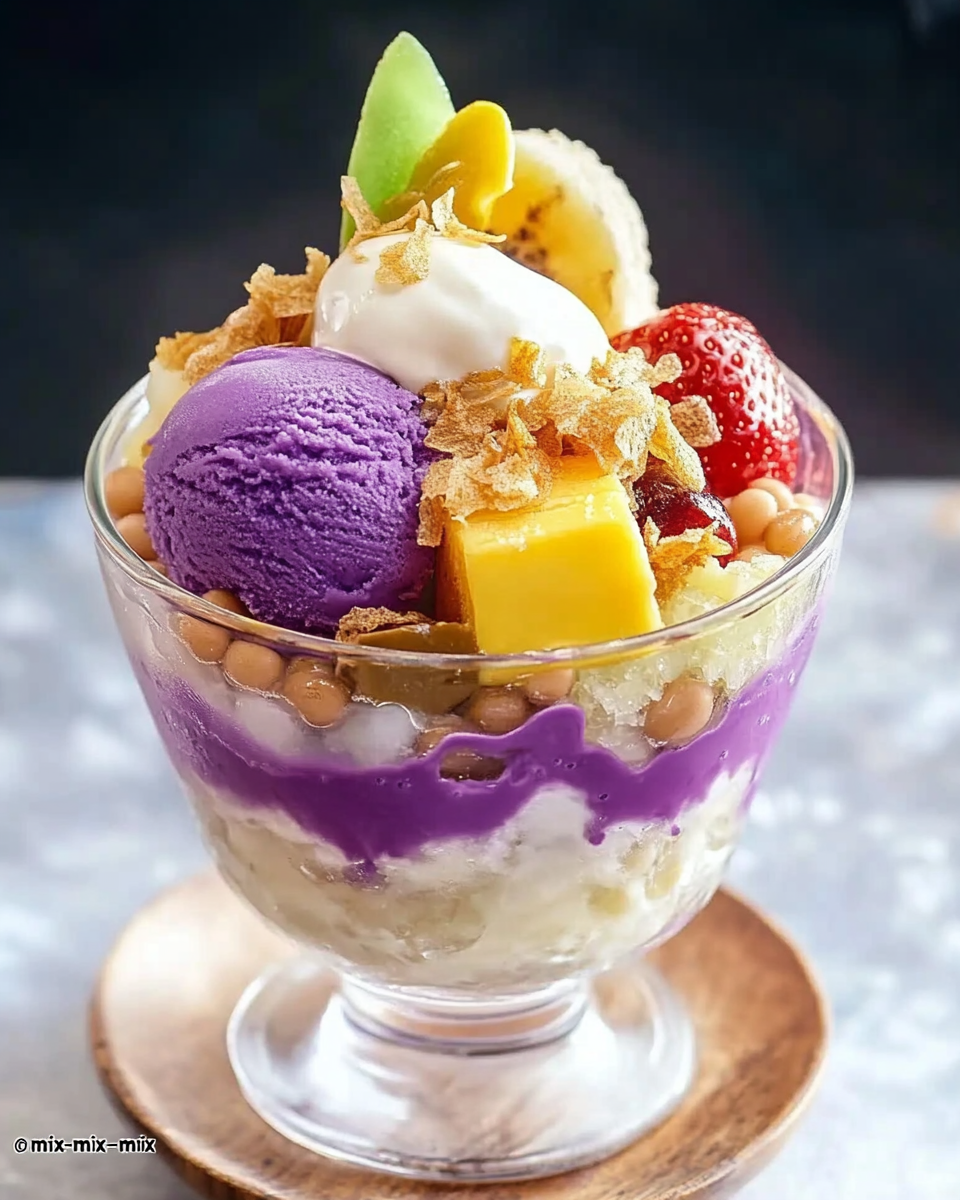Halo-Halo, meaning “mix-mix” in Filipino, is a beloved traditional dessert from the Philippines. It’s a colorful and refreshing treat made with layers of sweetened fruits, beans, shaved ice, and creamy toppings. Perfect for hot days, this dessert combines diverse textures and flavors into a single, irresistible glass.
FULL RECIPE
Ingredients
- 1/4 cup sweetened red mung beans
- 1/4 cup sweetened kidney beans
- 1/4 cup sweetened garbanzos
- 1/4 cup sweetened jackfruit (minced)
- 1/4 cup sweetened banana (saba, sliced)
- 1/4 cup nata de coco (coconut gel)
- 1/4 cup macapuno (coconut sport)
- 1/4 cup kaong (sugar palm fruit)
- 1/2 cup finely shaved ice
- 1/4 cup evaporated milk
- 1 scoop ube (purple yam) ice cream
- 1 tablespoon leche flan (caramel custard)
- Pinch of pinipig (toasted rice flakes, optional)
Directions
- In a tall glass or bowl, layer each sweetened ingredient starting with beans and fruits at the bottom.
- Add nata de coco, macapuno, and kaong in the middle.
- Pile the shaved ice on top of the layered ingredients.
- Drizzle evaporated milk evenly over the shaved ice.
- Add a scoop of ube ice cream on top of the ice.
- Place a small slice or spoonful of leche flan beside or atop the ice cream.
- Sprinkle with pinipig for extra crunch (optional).
- Serve immediately with a long spoon and mix before eating.
Nutritional Information
- Calories: 420 kcal
- Protein: 7 g
- Fat: 10 g
- Carbohydrates: 75 g
- Sugars: 45 g
- Fiber: 5 g
- Sodium: 90 mg
The History of Halo-Halo
Halo-Halo, a signature dessert of the Philippines, holds a deep cultural significance. Its name, meaning “mix-mix,” reflects the way the ingredients are blended together, forming a delicious medley of flavors. The dessert has roots in Filipino culinary history, influenced by various cultures, including Spanish and American colonization. Its evolution can be traced back to the early 20th century, when Filipinos began adding ice and milk to local fruits and sweet treats. Over time, the dessert became an iconic representation of Filipino summer cuisine, enjoyed during the hot months as a refreshing and satisfying treat.
The Origin of Halo-Halo’s Ingredients
The diverse ingredients in Halo-Halo showcase the Philippines’ rich agricultural resources. Many of the fruits and beans used in Halo-Halo are native to the region, and they are often cultivated in local farms. The use of sweetened beans, tropical fruits like jackfruit and banana, and various coconut-based ingredients speaks to the abundance of natural resources in the Philippines. Over the years, variations of Halo-Halo have emerged, with each region adding its unique twist, but the core ingredients remain a beloved constant.
Why Halo-Halo is a Filipino Staple
Halo-Halo’s popularity is undeniable, making it one of the most celebrated desserts in Filipino households and eateries. Its versatility and adaptability are key factors in its widespread appeal. The combination of textures, from the crunchy pinipig to the creamy ube ice cream, offers a delightful contrast, making it an exciting dessert for the senses. Halo-Halo transcends age and social status, enjoyed by children and adults alike. Whether at family gatherings, festivals, or casual dining, Halo-Halo has become a staple of Filipino cuisine.
The Role of Shaved Ice in Halo-Halo
One of the defining features of Halo-Halo is the finely shaved ice that forms the base of the dessert. The ice not only cools down the dish but also helps to blend the various ingredients together. The texture of the ice, when mixed with the sweetened fruits and beans, creates a refreshing and satisfying treat. The ice serves as a canvas for the colorful ingredients, allowing each layer to shine in the final mixture.
The Ubiquity of Ube in Filipino Sweets
Ube, or purple yam, is a beloved ingredient in Filipino desserts, and its prominent role in Halo-Halo is no exception. Ube ice cream, made from this vibrant tuber, adds both a rich flavor and an eye-catching color to the dessert. The creamy and slightly earthy taste of ube complements the sweetness of the other ingredients, bringing balance to the overall dish. Ube has become a symbol of Filipino culinary innovation, appearing in everything from cakes to pastries, and it remains a crucial part of the Halo-Halo experience.
Leche Flan’s Role in Halo-Halo
Leche flan, a Filipino caramel custard, is another essential component of Halo-Halo. This velvety, sweet custard adds a layer of richness that contrasts nicely with the crunchier and fruitier elements. The addition of leche flan elevates Halo-Halo to a more luxurious dessert, enhancing the overall indulgence. It’s often sliced and placed on top of the dessert, where it melts slightly from the surrounding shaved ice, infusing the entire dish with its creamy sweetness.
The Evolution of Halo-Halo Variations
While the traditional Halo-Halo recipe remains a favorite, numerous variations have sprouted over the years. Some versions include different fruits like mango or watermelon, while others might use tapioca pearls or sweetened corn. In some regions, Halo-Halo is served with a dollop of whipped cream or even topped with a drizzle of chocolate syrup. These variations allow the dessert to adapt to the tastes of modern diners while still maintaining its classic roots.
Halo-Halo in Popular Culture
Halo-Halo has made its way beyond the borders of the Philippines, becoming a symbol of Filipino culture globally. Many Filipino restaurants, both within the country and abroad, proudly serve Halo-Halo as a signature dessert. It has been featured in food blogs, cooking shows, and social media, further cementing its status as a cultural icon. The colorful nature of Halo-Halo makes it a perfect subject for Instagram and other social media platforms, showcasing the dessert’s vibrant hues and enticing layers.
Healthier Versions of Halo-Halo
While traditional Halo-Halo is a rich and indulgent dessert, healthier versions have been developed to cater to health-conscious consumers. Some people opt for sugar substitutes for the sweetened fruits and beans, while others focus on reducing the amount of condensed milk used. Non-dairy alternatives such as coconut milk or almond milk are also used in place of evaporated milk. For those watching their caloric intake, Halo-Halo can be made lighter by using fresh fruits and reducing the amount of ice cream or leche flan.
Halo-Halo in Special Occasions
Beyond being an everyday treat, Halo-Halo is often prepared for special occasions such as birthdays, holidays, and celebrations. In the Philippines, Halo-Halo is a staple at festive gatherings, often served in large bowls or in individual portions for guests to enjoy. The dessert has become a symbol of hospitality and generosity, with people eager to share this delicious dish with loved ones.
Pairing Halo-Halo with Filipino Dishes
Halo-Halo can be enjoyed on its own, but it is often paired with other Filipino dishes. The dessert’s cool, sweet flavors balance out the savory and sometimes spicy dishes commonly found in Filipino cuisine. For example, it pairs wonderfully with dishes like adobo, lumpia, and lechon, offering a refreshing contrast to the richness of these savory foods. The combination of salty and sweet flavors adds a layer of complexity to the meal experience.
The Popularity of Halo-Halo Outside the Philippines
Filipinos living abroad have brought Halo-Halo to new corners of the world, introducing it to non-Filipino audiences. As Filipino communities have grown in countries like the United States, Canada, and the Middle East, Halo-Halo has made its way into the mainstream. Filipino restaurants, food trucks, and even international chains now offer the dessert, introducing this unique culinary creation to a global audience. Its widespread popularity speaks to the growing appreciation for diverse international cuisines.
The Importance of Presentation in Halo-Halo
Halo-Halo’s visual appeal plays a significant role in its popularity. The vibrant colors of the fruits, ice cream, and toppings make it an Instagram-worthy dish. Presentation is an important factor when serving Halo-Halo, as the layers should be distinct and well-arranged. The contrast of colors and textures makes the dessert even more enticing, and the ritual of mixing all the ingredients together adds an element of fun.
Seasonal Variations of Halo-Halo
While Halo-Halo is traditionally associated with summer, there are seasonal variations of the dessert that reflect the changing availability of fruits and ingredients. In the cooler months, for example, some versions might incorporate more warming ingredients like sweet potato or roasted nuts. These seasonal adaptations add new flavors and textures to the dessert, ensuring that it remains relevant year-round.
Halo-Halo and Filipino Identity
Halo-Halo is not just a dessert; it is a symbol of Filipino identity and culture. The act of mixing the ingredients together can be seen as a metaphor for the diversity of the Filipino people, coming together to create something beautiful and unified. Halo-Halo is a reflection of the nation’s history, culture, and ingenuity, and it has become a way for Filipinos to celebrate their heritage.
The Appeal of Halo-Halo to All Ages
Halo-Halo’s ability to appeal to people of all ages is another reason for its enduring popularity. Children enjoy the fun of mixing the ingredients and savoring the sweet flavors, while adults appreciate the nostalgic connection to their childhood. Halo-Halo serves as a bridge across generations, bringing families together to enjoy a shared cultural experience.
Halo-Halo as a Crowd-Pleaser
Whether served at a small family gathering or a large party, Halo-Halo is a crowd-pleaser. Its combination of sweet, creamy, and crunchy elements appeals to a wide range of tastes, ensuring that everyone will find something to enjoy. The customizable nature of Halo-Halo means that you can tailor it to suit the preferences of your guests, making it an ideal choice for events and celebrations.
The Role of Local Ingredients in Halo-Halo
The use of local ingredients is what gives Halo-Halo its distinct Filipino flavor. Ingredients like coconut gel, macapuno, and sweetened banana are all native to the Philippines and bring a unique texture and taste to the dessert. The inclusion of these local ingredients not only supports local farmers but also allows the dessert to maintain its authenticity and connection to Filipino culture.
Advertisement
Why Halo-Halo Is Loved by Non-Filipinos
One of the reasons Halo-Halo is gaining popularity among non-Filipinos is its unique combination of flavors and textures. The dessert offers a refreshing change from more traditional Western desserts, with its balance of sweet, savory, and creamy elements. The playful nature of mixing the ingredients together also adds an interactive component that appeals to many people unfamiliar with Filipino cuisine.
Conclusion
Halo-Halo is more than just a dessert; it is a celebration of Filipino culture, history, and creativity. With its colorful layers, refreshing textures, and delightful combination of sweet and savory ingredients, it remains one of the most iconic and beloved Filipino treats. Whether enjoyed on a hot summer day or as a special treat at a festive gathering, Halo-Halo is a timeless dish that brings people together, offering a sweet taste of the Philippines to the world.






